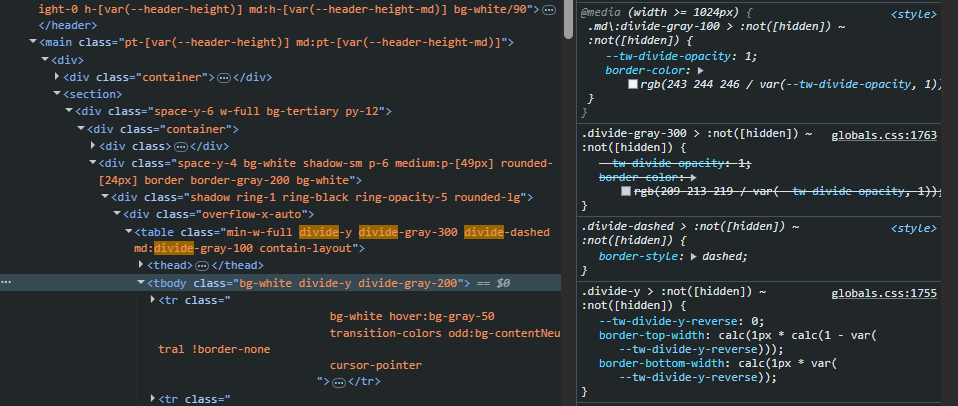Style Recalculation time is not something for everybody to worry about, but it doesn't mean that you shouldn't watch out for common mistakes when creating the front-end layer. In today's world, where we simply want to forget about CSS, it's not as simple as slaping a class on a div and forgetting it exists. Now be prepared for a bit tech-savy introduction to the subject:
What's style recalculation, why it exists and how it works in a brief overview.
Style recalculation is the browser process of determining which CSS rules apply to each DOM element and computing their final style values. This process exists because web pages are dynamic - elements can be added, removed, or modified through JavaScript, CSS classes can change, and media queries can activate based on viewport changes. When any of these changes occur, the browser must recalculate styles to ensure the visual representation matches the current state of the DOM and CSS rules.

There are several types of invalidation: element invalidation occurs when an element's own properties change (like adding a CSS class), subtree invalidation happens when changes affect an element and all its descendants (such as modifying inherited properties like font-family or color), and sibling invalidation triggers when changes impact adjacent elements (often due to CSS selectors like :nth-child or + combinators). The browser maintains invalidation sets and traverses the DOM tree to mark elements as "dirty" when their computed styles may have changed, ensuring that only necessary recalculations occur during the next style resolution phase. This selective approach significantly improves performance by avoiding redundant work, especially in complex applications with frequent DOM manipulations.
Now we also have Immediate invalidation - this occurs when the browser processes style changes synchronously as soon as they're triggered, typically during critical operations like layout queries (accessing offsetWidth, getBoundingClientRect()) that force the browser to ensure styles and layout are up-to-date before returning values. Pending invalidation, on the other hand, is the browser's optimization strategy where style changes are marked for future processing but not immediately computed - instead, they're batched and deferred until the next rendering frame or until explicitly flushed by layout-forcing operations. This pending approach allows the browser to coalesce multiple style changes together, avoiding redundant calculations when multiple DOM modifications happen in quick succession.
When invalidations and style recalculations can become a bottleneck in your website/application
-
Complex selector patterns - can cause a lot of overhead, particularly descendant selectors with multiple levels like .container .sidebar .menu li a span which force the browser to traverse up the DOM tree for every element match. Universal selectors combined with descendant patterns (* .class or .parent * .child) create exponential matching complexity. Adjacent sibling selectors (+) and general sibling selectors (~) become expensive when used deeply in the DOM tree, especially in combination like .item + .item + .item, as the browser must check sibling relationships for every element.
-
Pseudo-selectors with dynamic states significantly impact performance, particularly :nth-child(), :nth-of-type(), and :nth-last-child() selectors, which require the browser to count and re-evaluate element positions whenever the DOM changes. Complex :not() selectors that contain multiple conditions or other complex selectors inside them can cause cascading performance issues. Attribute selectors with wildcards like [class*="btn"] or [data-*^="prefix"] force string matching across many elements.
-
Large DOM trees with broad invalidation create problems when changes affect elements high in the hierarchy, causing style recalculation to cascade down through thousands of descendants. CSS custom properties (CSS variables) can trigger extensive recalculation when changed at the root level, as all dependent properties must be recomputed. Media queries that frequently toggle (like hover states or resize events) combined with complex selectors amplify the performance impact, as the entire matching process repeats with each state change.
-
Large CSS files increase selector matching time because the browser must evaluate more rules against each DOM element - with thousands of CSS rules, the matching engine has to process significantly more potential matches for every element during recalculation.
So what classes we don't like in Tailwind when it comes to causing prolonged recalculation times?

Do you see how this can quickly get out of hand? This is a shorthand created by the Tailwind team so we don't have to manually assign borders to repetitive children in our UI - but this class underneath is very complex, and the selector pattern created by it can cause issues in certain conditions. Best would be to just use border classes instead.
The same case applies to our space-x and space-y classes. Both of these are trying to relieve us from repetitive tasks while adding a lot of complexity to the selector and, in the end, creating more things that the browser needs to check while we perform actions on the website.